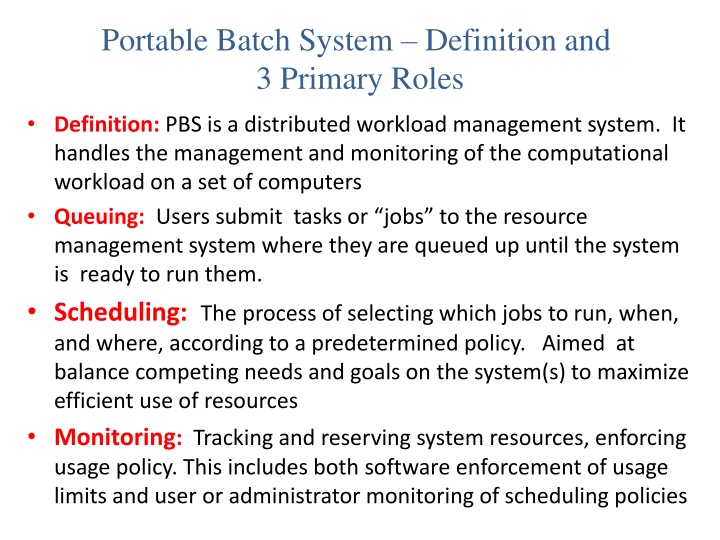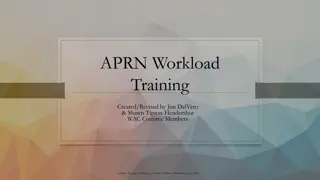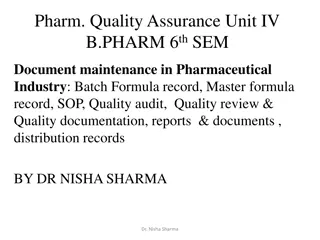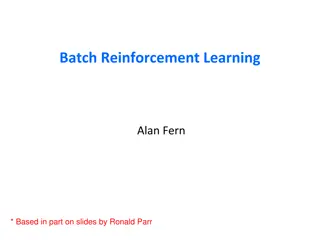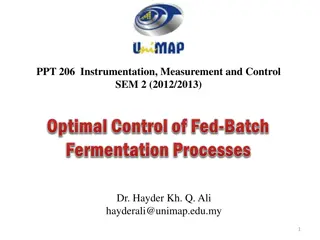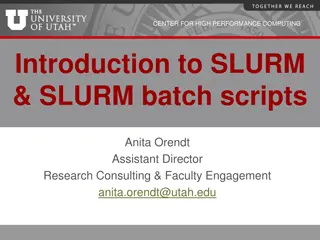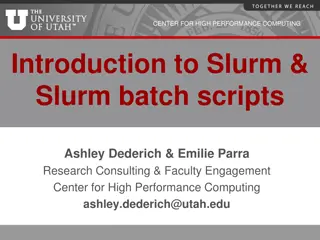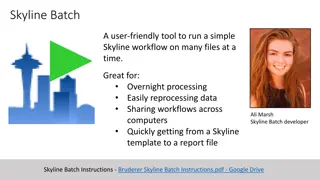Portable Batch System: Distributed Workload Management & Job Submission
PBS, a Portable Batch System, is a distributed workload management system that handles computational tasks across computers. Users submit jobs which are queued until ready to run. The system balances job scheduling to optimize resource use, monitored for policy enforcement. Job submissions use qsub commands, specifying tasks, resources, and attributes. Aluf queues categorize jobs based on CPU and time limits. PBS shell scripts contain directives to request resources. An example script is provided for multicore use.
Download Presentation

Please find below an Image/Link to download the presentation.
The content on the website is provided AS IS for your information and personal use only. It may not be sold, licensed, or shared on other websites without obtaining consent from the author.If you encounter any issues during the download, it is possible that the publisher has removed the file from their server.
You are allowed to download the files provided on this website for personal or commercial use, subject to the condition that they are used lawfully. All files are the property of their respective owners.
The content on the website is provided AS IS for your information and personal use only. It may not be sold, licensed, or shared on other websites without obtaining consent from the author.
E N D
Presentation Transcript
Portable Batch System Definition and 3 Primary Roles Definition: PBS is a distributed workload management system. It handles the management and monitoring of the computational workload on a set of computers Queuing: Users submit tasks or jobs to the resource management system where they are queued up until the system is ready to run them. Scheduling: The process of selecting which jobs to run, when, and where, according to a predetermined policy. Aimed at balance competing needs and goals on the system(s) to maximize efficient use of resources Monitoring: Tracking and reserving system resources, enforcing usage policy. This includes both software enforcement of usage limits and user or administrator monitoring of scheduling policies
Submitting jobs to PBS: qsub command qsub command is used to submit a batch job to PBS. Executed on aluf (login node). Submitting a PBS job specifies a task, requests resources and sets job attributes, which can be defined in an executable scriptfile. Recommended syntax of qsub command : > qsub PBS script files ( PBS shell scripts, see the next page) should be created in the user s directory To obtain detailed information about qsub options, please use the command: > man qsub Job Identifier (JOB_ID) Upon successful submission of a batch job PBS returns a job identifier in the following format: [options] scriptfile > sequence_number.server_name > 12345.aluf01
ALUF Queues Description all_q - default routing queue, navigates jobs to respective destination queues according to the Wall time and CPUs number (ncpus) request in the PBS script multicore - parallel jobs up to 4 CPUs, time limit 24 hours short main long For detailed up-to-date information on queues limits please type: "qstat -fQ queue_name" - Serial jobs, (1 CPU), time limit 3 hours - Serial jobs,(1 CPU), time limit 24 hours - Serial jobs,(1 CPU), time limit 72 hours
The PBS shell script sections Shell specification: #!/bin/sh PBS directives: used to request resources or set attributes. A directive begins with the default string #PBS . Tasks (programs or commands) - environment definitions - I/O specifications - executable specifications NB! Other lines started with # are comments
PBS script example for multicore user code #!/bin/sh #PBS -N job_name #PBS -q queue_name #PBS -M user@technion.ac.il #PBS -l select=1:ncpus=4 #PBS -l select=mem=8 GB #PBS -l walltime=24:00:00 PBS_O_WORKDIR=$HOME/mydir cd $PBS_O_WORKDIR ./program.exe < input.file > output.file Other examples see at http://tx.technion.ac.il/doc/aluf/PBS-scripts/
Checking job/queue status: qstat command qstat command is used to request the status of batch jobs and queues Detailed information: > man qstat qstat output structure (see on Tamnun) Useful commands > qstat a all users in all queues (default) > qstat -1n all jobs in the system with node names > qstat -1nu username all user s jobs with node names > qstat f JOB_ID extended output for the job > Qstat Q list of all queues in the system > qstat Qf queue_name extended queue details qstat 1Gn queue_name all jobs in the queue with node names
Removing job from a queue: qdel command qdel used to delete queued or running jobs. The job's running processes are killed. A PBS job may be deleted by its owner or by the administrator Detailed information: > man qdel Useful commands > qdel JOB_ID deletes job from a queue > qdel -W force JOB_ID force delete job
Checking a job results and Troubleshooting Save the JOB_ID for further inspection Check error and output files: job_name.eJOB_ID;job_name.oJOB_ID > tracejob [-n N] JOB_ID Inspect job s details (after N days ) : > ssh aluf01 Running interactive batch job: > qsub I pbs_script Job is sent to an execution node, PBS directives executed, shell control is passed to user, job awaits user s command Checking a job on an execution node: > ssh node_name (aluf01 or aluf02, or aluf03) > hostname > top /u user - shows user processes ; /1 CPU usage > kill -9 PID remove job from the node > ls rtl /gtmp check files under user s ownership
